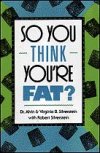Packing Fat Addtional Information
______. 2004. Building a food pyramid. Science News for Kids (Feb. 18). Available at http://www.sciencenewsforkids.org/2004/02/building-a-food-pyramid-2/.
______. 2003. Turning to sweets, fats to calm the brain. Science News for Kids (Sept. 17). Available at http://www.sciencenewsforkids.org/2003/09/turning-to-sweets-fats-to-calm-the-brain-2/.
______. 2003. In search of the perfect french fry. Science News for Kids (July 23). Available at http://www.sciencenewsforkids.org/2003/07/in-search-of-the-perfect-french-fry-3/.
Raloff, Janet. 2004. Honey, let’s shrink the kids. Science News Online (Oct. 9). Available at http://www.sciencenews.org/articles/20041009/food.asp.
 |
So You Think You’re Fat? — Virginia Silverstein
Published by HarperCollins, 1991.
When you see super-skinny models on television, in the movies, and in magazines, you may think you are fat. But are you really overweight? And if you are, what are some healthy ways that you can go about getting into shape? This book looks at why people get fat and how they can change their eating habits and exercise routine to become more physically fit. It also considers the way our culture stresses thinness and discusses such eating disorders as anorexia and bulimia. |
 |
Eat Smart: A Guide to Good Health For Kids — Dale Figtree
Published by New Wind Publishing, 1992.
James loves junk food. Before he knows it, he’s put on weight. Then his mother introduces him to Joanna, a nutritional counselor, and he learns just how good healthy food can be. He adds exercise to his routine and gets his eating—and weight—under control. Cartoon drawings illustrate James’s introduction to good eating habits. |
Power Words
diabetes A disease in which a person has too much sugar in the blood. In diabetes, the body does not produce enough of a hormone called insulin, which helps the body take up sugar from the blood. If not treated, diabetes can cause damage to nerves and blood vessels.
fat An oily substance that is produced by plants and animals and that serves as a source of energy. In mammals, fat lying under the skin and around the organs prevents the loss of heat and provides protection. Fats are made mostly of fatty acids.
Copyright © 2002, 2003 Houghton-Mifflin Company. All rights reserved. Used with permission.








